How To Create A Scrum Board
Want to learn how to use a Scrum board ?
While Scrum boards may sound like a boring variation of a checkerboard, they're incredibly interesting and helpful.
Over the years, Scrum boards and Scrum tools have become a staple of Scrum and Agile Software development. They can help you monitor your task progress and keep things ticking along quickly.
In this Scrum guide, you'll learn what is a Scrum board , how to build one, and how to use it.
We'll also highlight the best Scrum task board tool available in 2021!
This Article Contains:
(Click on the links to jump to a specific section)
- What is Scrum ?
- Core aspects of the Scrum methodology
- What is a Scrum board ?
- 2 types of Scrum boards
- Who should use Scrum boards ?
- How to use a Scrum task board ?
- 3 Key benefits of using a Scrum board
- How is a Scrum board different from a Kanban board ?
- The best Scrum task board tool for 2021
Let's get started!
What Is Scrum?
Note: These sections are only for those who aren't familiar with Agile and Scrum . If you only want to learn about Scrum boards , click here to jump to that section.
Scrum is an Agile project management methodology that involves customer feedback to adapt to sudden project changes. Scrum project management helps development teams manage their product development
But wait!
What is Agile project management , and how is it different from regular management?
In traditional development processes, both in-house and virtual teams work on a software project for months and then deliver the final product. However, in the Agile methodology , you break your project into smaller product development cycles.
These development cycles are called sprints and allow your team to work on them independently. Once each Scrum sprint is finished, you present it to your customers and then incorporate their feedback.
How does this help?
You're actively involving your customers in the product development process. Their feedback helps you incorporate multiple project changes based on actual customer experience, not just assumptions!
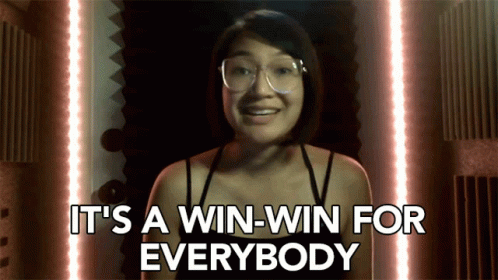
Here's an example:
Let's say you're building an app.
You could go through a year of planning, testing, and development before delivering it to your customers.
Except there's one problem: they might not like all the features in your app!
Instead of facing that problem, adopt the Agile methodology .
Here, you develop your app in stages.
After you complete each stage, you present it to your customers. They'll then give you their feedback , and you can make those changes immediately before moving onto the next step.
This way, you're actively including your customers in the development process and will be able to deliver a product that they can't get enough of!
So how does the Scrum framework fit in with the Agile methodology ?
A Scrum team follows the principles of Agile development , to improve teamwork and increase productivity. It's a subset of Agile that aims to make it quicker and more efficient!
Core Aspects Of The Scrum Framework
Scrum can help you involve your customers and adapt to sudden project changes.
Great, right?
But before trying out the Scrum approach, here are a few Agile software terms you must know:
1. User story
A user story is used to describe one or more features of a product in Scrum project management . Each story is assigned a story point , a metric that shows how difficult it is to implement that particular story (feature).
A user story answers the following questions:
- Who is the user?
- What features do they want?
- Why do they want these features?
2. The sprint
The Scrum sprint is a fixed time period of 1-4 weeks. Within this time, a Scrum team works on each development cycle.
3. Product backlog
The product backlog is a list of items that should be done to complete the Scrum project . It contains all the features, user stories , improvements, and bug fixes that should be done for future releases.
4. Sprint backlog
The sprint backlog is a list of product backlog items that the Scrum team can complete during a specific sprint . This list is decided during the sprint planning phase , where the team maps out what they'll do before they begin a sprint .
Both the product backlog as well as the sprint backlog go through backlog refinement . In backlog refinement , you update each product or sprint backlog item to ensure that they reflect project changes accurately.
5. Sprint team
In Scrum , cross-functional teams work together to finish the project .
A Scrum team consists of:
- Product owner : they have the vision for what the final product needs to be. They lead the Scrum process and relay customer feedback to the team .
- Scrum master : they ensure that the team follows the principles of the Scrum framework
- Development team : a small, self-organizing group of employees with a diverse skill set. The development team members can include UI/UX designers, graphic designers, coders, and writers.
6. Sprint retrospective
After the sprint is completed, the Scrum team holds a sprint retrospective meeting to review the sprint . The team identifies what processes worked and what didn't in the current sprint . This helps them analyze the bottlenecks faced and determine solutions for a future sprint .
What Is A Scrum Board?

Right, so we can finally get down to talking about Scrum boards .
So what are they, and what makes them so valuable?
Also known as a sprint board, a s crum board is a visual representation of the work to be done in a single sprint .
The Scrum board allows the Scrum team to:
- Identify the tasks that need to be completed
- Ensure that everyone is working on a project task
- Keep track of the progress of an active sprint
Teams hold their daily Scrum or stand-up meetings in front of a Scrum board to discuss how their day went.
What is the structure of a Scrum board ?
Here's what goes into a Scrum board :
A basic Scrum board is a digital or physical board that is divided into four vertical columns. Here are the key elements of Scrum task boards :
- Stories : the user stories in the current sprint backlog that need to be divided into tasks
- To do : the tasks and subtasks which have not been started yet. These are visualized as cards or sticky notes and include details like due dates and owners (the team members working on the Scrum task ).
- Work in progress : the tasks your team is currently working on
- Done : the tasks which have been completed
Here's a Scrum board template to give you a visual idea of what we're talking about:

Based on your Scrum process, you can also create additional columns for added functionality.
Here are few handy columns you can add:
- In Review: includes tasks that have been completed, but need to be tested or quality checked
- On Hold : includes tasks that you won't work on in this Scrum sprint , but might be added during future sprint planning sessions
2 Types Of Scrum Boards
While most project management activities are done digitally these days, some people still prefer the physical approach.
(Nope, we don't know why either!)
There are just two kinds of Scrum boards you can use:
- Physical board
- Digital Scrum board
Here's a guide on which one you should choose:
A. Physical Scrum board
You can create a physical Scrum task board on any surface , whether it be it a whiteboard or a corkboard.
Divide your board into the usual 3 columns — ' To do ', 'WIP', and 'Done' . Each individual task in the sprint is then written on a sticky note .
As your team works on the Scrum task , they can move the sticky notes around to their respective columns in the task board .
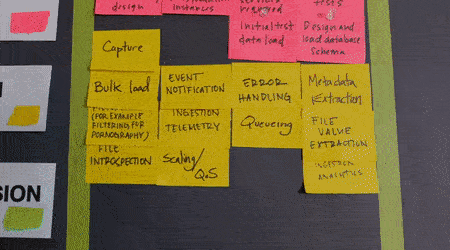
B. Online Scrum board
An online Scrum board is a digital representation of a physical task board .
Instead of sticky notes , project tasks are visualized on a digital task card .
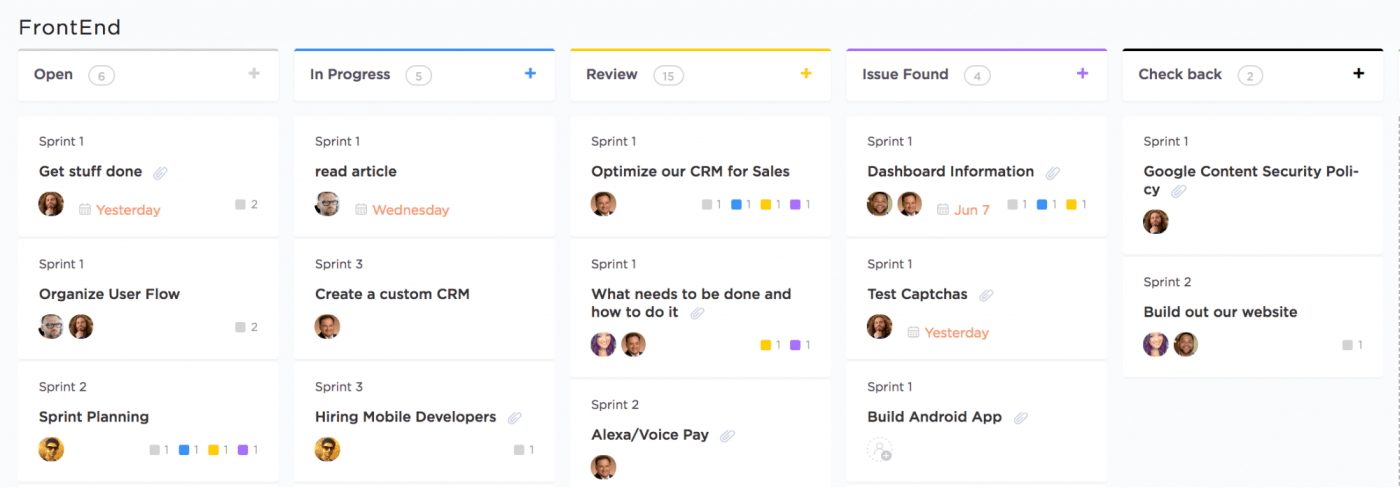
So which one is better? A virtual Scrum board or a physical one?
That's like comparing the latest iPhone to a desk phone from the 1900s!
Physical Scrum boards are ridiculously outdated and can even take up valuable office space.
It's far better to use an online Scrum tool , as they are packed with features that can increase your productivity .
Here are some benefits of using an online board :
- Online Scrum software can be automated, so the tasks automatically move from one column to another once you update the task status
- More than one person can use an online Scrum board at a time
- A remote team can use an online board to track progress across continents
- You can customize the colors and templates of a task card
- Unlike a whiteboard , you can view online Scrum boards on multiple devices on the go
- These boards integrate with other tools, reports, and documents
Who Should Use A Scrum Board?
Software development, sales, and HR could all benefit from using a scrum board. And while Scrum task boards are generally custom-built for Agile and Scrum teams, they're also used by tons of other teams!
Here's how different departments use Scrum boards :
- Software development : to track a project's progress
- Sales : to track their deliverables and meet their targets in a short amount of time
- HR : to streamline the recruitment process
How To Use A Scrum Task Board?
Okay, so Scrum boards are incredibly helpful.
But how do you go about creating one for your Scrum or Agile team ?
Here's how you can set up and use a Scrum board in 5 simple steps:
Step 1: Identify user stories
During the sprint planning phase, your team should select each product backlog item that they would like to work on in the sprint . After selecting the user stories they want, add it to the sprint backlog .
Step 2: Assign tasks
The team then splits user stories into individual tasks .
All tasks are moved to the ' To-Do ' column.
Your team then begins to work on each Scrum task .
Step 3: Work on project tasks
As the sprint progresses, your team members move the tasks from left to right on the board. Tasks gradually shift from ' To-do ' to ' In Progress or In Process '.
The team updates the board regularly and adds new tasks (if needed) during their daily scrum meetings . The Scrum master also reviews the progress of the tasks continually and makes any necessary adjustments.
Step 4: Finish all tasks
When a team member moves a task all the way from ' To-Do ' to 'Done' , they go back to the leftmost column ( 'To-Do' ) and tackle the next pending task .
By the end of the sprint , all tasks from the stories should be in the Done column .
Step 5: Review sprints
The Scrum master should hold a sprint review at the end of your sprint process.
Here's what happens in a sprint review :
- The team members and stakeholders discuss what tasks were completed and what were not
- The Scrum master identifies any problems faced by the team and provides solutions
And that's it!
3 Key Benefits Of Using A Scrum Board
So why should you use a Scrum board ?
The real question should be:
Why shouldn't you use a Scrum board ?!
Let these benefits speak for themselves:
1. Improves team efficiency and communication.
The Scrum task board brings the whole team together.
At the end of the day, the project manager , the Scrum Master , and team members can gather near a task board and discuss:
- Who's working on a particular task
- What tasks are getting completed
- Where help may be required
2. Easy setup and deployment
An online board is ridiculously easy to set up and use.
Project management tools allow you to drag and drop tasks from different sprint board columns instantly. They also come with powerful automation and reporting features to help new users get used to the Scrum methodology and its boards.
3. Makes it easy to recognize problem areas
As a sprint board visualizes the top priorities and current issues, it's impossible to forget a task!
(And when you're dealing with as many tasks as Scrum teams do, it's super easy to lose track of them.)

It also highlights the tasks that are progressing slowly. With this information, you can quickly step-in and address these bottlenecks.
How Is A Scrum Board Different From A Kanban Board?
At first glance, a Scrum task board looks quite similar to a Kanban board (another Agile board ).
But don't be fooled!
Yes, both these boards use post-it notes or 'cards' to communicate the status of a task.
However, Scrum task boards are mostly used by Agile software development teams . Meanwhile, Kanban boards can be used by every team in the office.
Here are a few more differences between a Scrum board and a Kanban board :
1. Scope of work
A) Scrum board – A Scrum board tracks the work done in a single sprint by a single Scrum team . The board doesn't contain tasks outside the current sprint backlog .
B) Kanban board – A Kanban board tracks the workflow of all the teams working on a project . The team can add any tasks they have to the Kanban board .
2. Work in progress limits
A) Scrum board – Scrum teams need to finish a lot of work in a single sprint . That's why there is no limit to the number of tasks they can have in the ' Work in progress ' column at the same time ( although you still have to get it all done by the deadline ).
B) Kanban board – Kanban boards are built to improve team productivity. That's why there's usually a fixed limit to the number of tasks the team can have in a 'Work in Progress' column.
3. Owners
A) Scrum board – A Scrum board is always owned by one Scrum team that is working on a sprint .
B) Kanban board – A Kanban board is not owned by any specific team and is usually devoted to the company's overall workflow.
4. Board Content
A) Scrum board – Teams break down user stories into small tasks and add them to the sprint backlog . The members then work on these sprint backlog tasks.
B) Kanban board – Since non-technical teams also use Kanban boards, user stories and sprint backlogs are generally not considered when creating tasks for these boards.
5. Reports
A) Scrum board – A Scrum team uses data from the Scrum task boards to create velocity charts and other graphs. These charts measure your team's progress rate based on the number of tasks completed in a sprint .
B) Kanban board – Most teams don't use Kanban board data to create charts or graphs. They're just a simple solution for the team to reorganize items as a project progresses.
Which Agile Scrum Board Should You Choose? ClickUp, of Course!
If you want to adopt the Scrum methodology , you need the right project management tool .
Think about it.
Do you really want to manage your projects with a post-it or a whiteboard ?
I mean, you could but…

Why use that when a project management tool like ClickUp exists?
ClickUp was built to deal with any Agile method , and it's going to make adapting to Scrum a piece of cake!
But what's ClickUp?
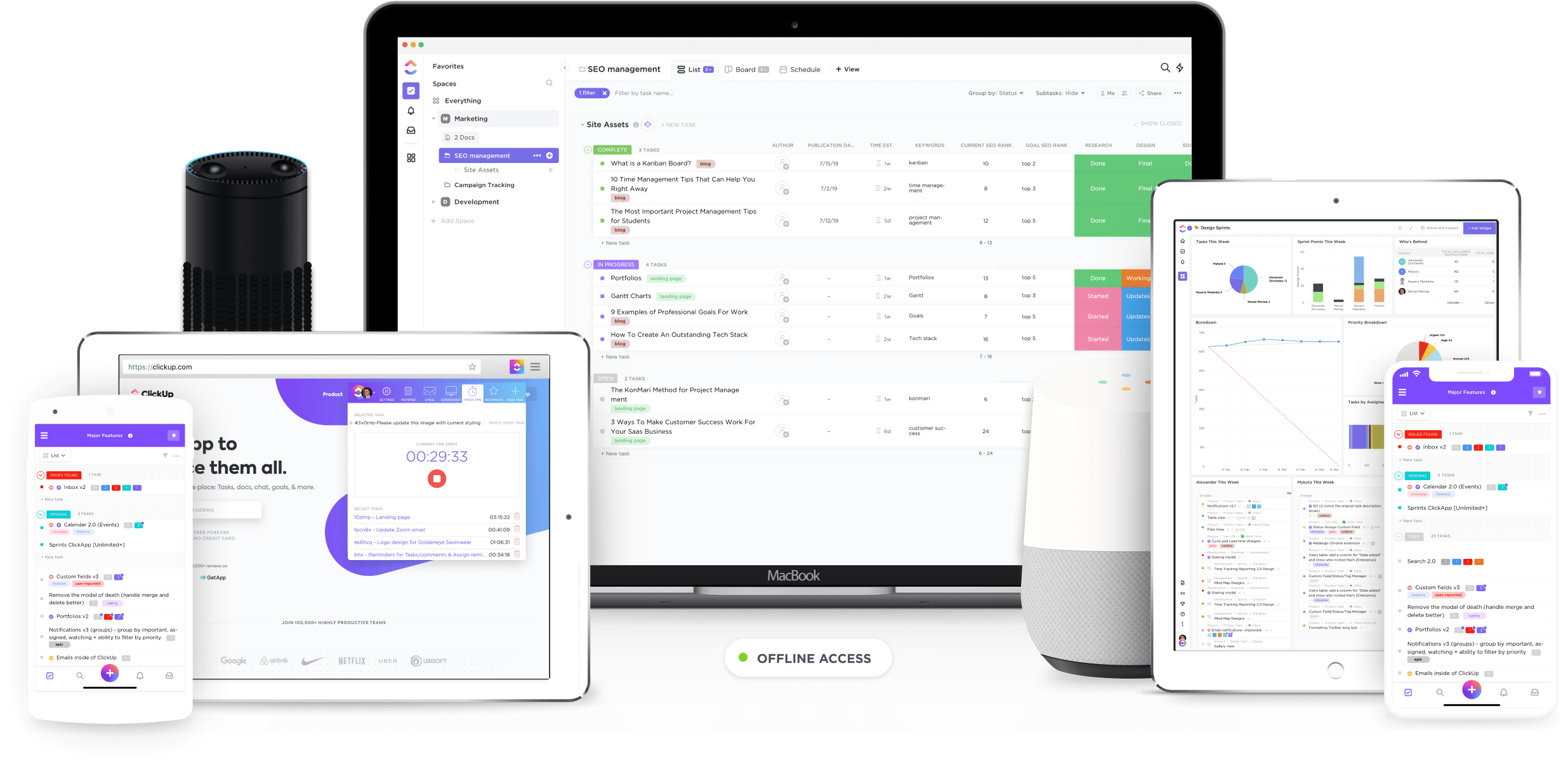
ClickUp is the world's highest-rated Agile project management tool and has everything you need to cope with Agile project management .
Whether it's managing multiple projects or monitoring the productivity of your distributed team , this Scrum tool can handle it all!
Here's how ClickUp's Board view is the perfect way to manage a Scrum or Kanban board :
What's ClickUp's Board view ?

This view visualizes your tasks and projects as an interactive sprint board or Kanban board . It makes it super convenient for you to view all your Scrum tasks in one place!

Here are the features that make this the perfect view for you:
1. Drag and drop functionality for maximum ease-of-use
Just like a physical board , you can drag and drop ClickUp tasks to the correct status columns.
This makes it incredibly easy to move any task card around quickly!
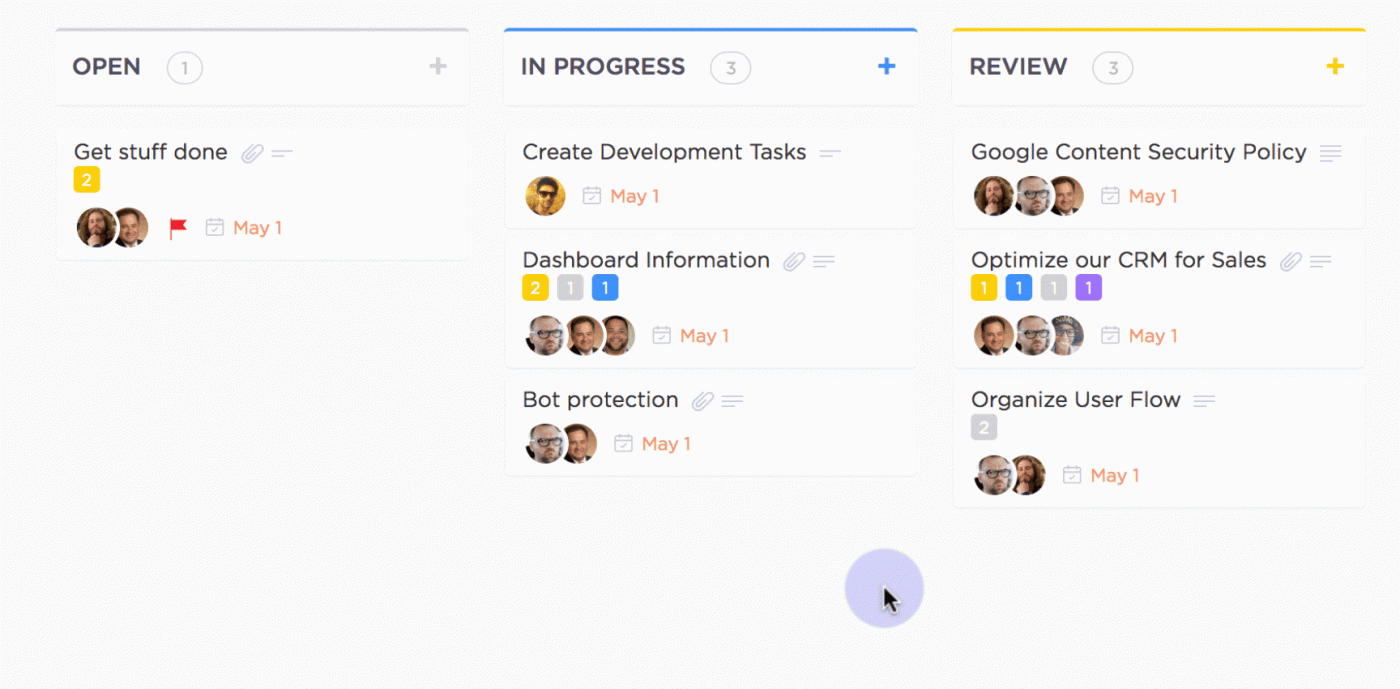
2. Custom Task Statuses for easy task identification
In Board view, the ' task status ' is basically the name of the column. You can change the status of a task just by dragging and dropping them into a relevant column.
For example, if you're working on a blog post, you can quickly move a task from "Draft in progress " to "Editorial review" in seconds!
However, that isn't all.
You don't have to use the same statuses for every project .
Based on your workflow, you can create tailor-made customized statuses. Create as many statuses you want and save them as a template for future usage.

3. Sort and filter features to make categorization easier
Do you really want to sift through tons of tasks to find the data you want?
Because if you do, you're going to look like this:

Don't worry.
ClickUp's going to ensure you never want to pull your hair out.
In this Agile tool , your Board view columns aren't just organized from left to right like a boring, regular Scrum board .
You can sort columns individually to highlight important tasks at the top of the column .
You can also organize your tasks based on task status , name, priority, and more!

Here are some of the filters this Scrum tool provides:
- Status : view only tasks within a particular task status
- Due Date : identify tasks that need to be completed soon
- Assignee : view tasks assigned to a specific Scrum team member
4. Tags to group items quickly
Need even more features to help you organize your tasks?
Tags can make your life so much easier. By tagging a task , you can instantly categorize it to make it more recognizable.
Here's how you do it:
Just hover over your task and click the Tag symbol to edit and create a Tag to identify the process.

Now you won't have to scramble to find a Scrum task .
Just filter by Tags to find all your relevant tasks!

5. Multiple Views to cater to your team's needs
ClickUp is a rare Scrum software that can cater to your entire company.
That's crazy, right?!
I mean, project management software is supposed to help your whole team (even if it's a small team ) . But as 95% of tools only cater to one department, several teams are forced to use multiple apps just to get a grip on things.
But that's not the case with ClickUp.
Your team has access to tons of other views to organize their tasks in the way they want .
As every team member can choose their own view, they're not forced to use something they're not suited to — ensuring that they avoid this:

Here are some of the views this Agile tool offers to your team :
A. List view
This view is perfect for users who look to simply get things done !
It arranges all your tasks in a neat to-do list. You can then go ahead and check off items as you progress !

B. Box view
This view is perfect for high-level overviews of what your team is working on. Tasks can be sorted out by assignee, so you can keep track of everyone's tasks and monitor their progress quickly.
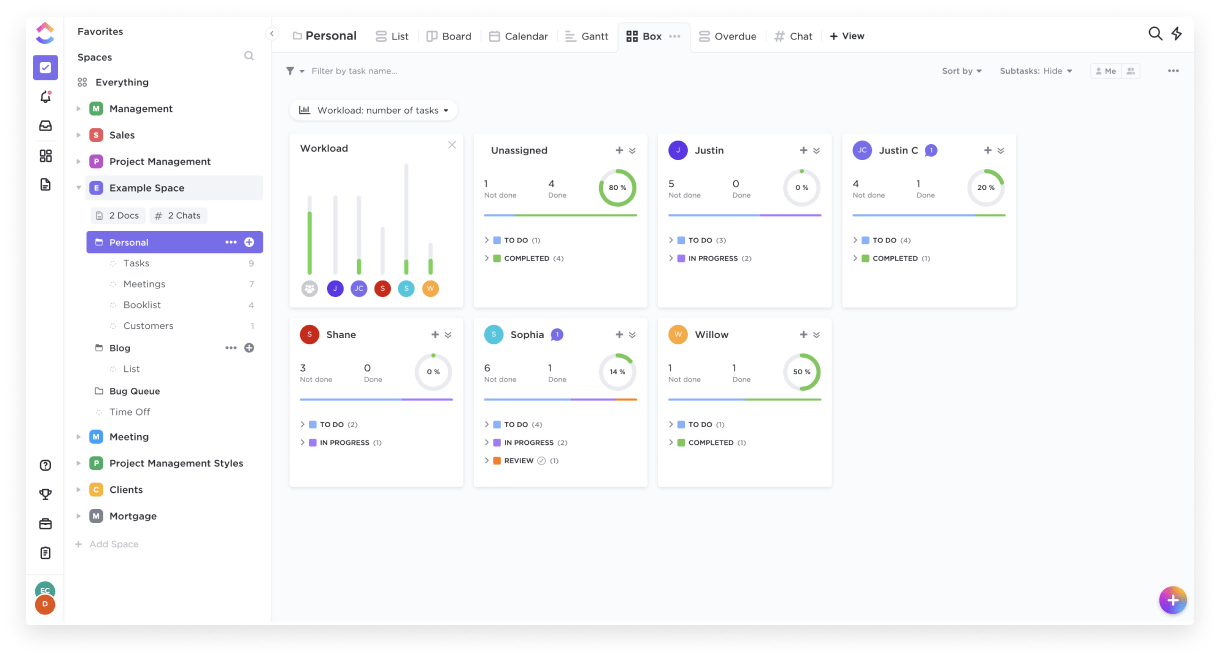
C. Calendar view
Want to manage your busy schedule quickly?
I mean, doesn't everyone?
ClickUp's Calendar is the perfect way to do it.

Toggle between views in your calendar, such as:
- Days : view scheduled project tasks on a given date
- 4-Days : see your project schedule over a rolling four-day period
- Week : look at your weekly project schedule
- Monthly : for a high-level view of what's coming up over the next month
D. Me Mode
The "Me" Mode lets you only view the backlog items assigned to you in your Workspace. You can now focus on your individual tasks without looking at any unrelated tasks!
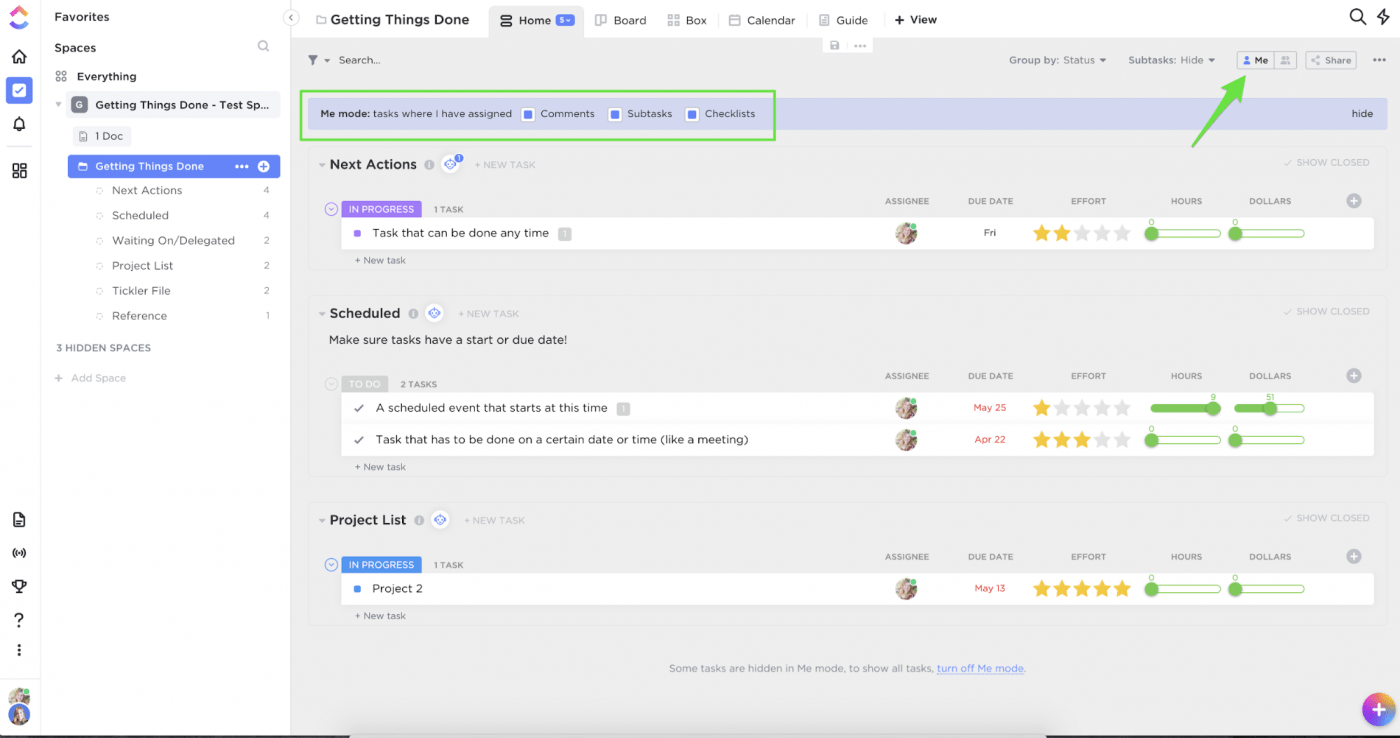
The best part?
ClickUp is the only project management tool that lets you toggle between views with a single click! This way, you can switch between these multiple views while working on different parts of your Scrum project .
How convenient is that?!

However, these aren't all that ClickUp has to offer!
This Scrum and Kanban tool also offers tons of powerful features, like:
- Project Management Automation : automate 50+ repetitive project tasks to save time
- Pulse : know what your in-house or remote team is most focused on during a given day
- Priorities : task prioritization to help your team know what's urgent
- Notepad : capture ideas quickly during your sprint review , sprint retrospective or sprint planning meeting
- Goals : break down your sprint goal into smaller, achievable Targets
- Dashboard : choose from various graphs like a Burnup , Cumulative Flow , Velocity , or Burndown chart to create a custom mission control for your projects
- Docs : create any sprint report with powerful editing and real-time collaboration features
- Team Reporting : access detailed reports to analyze the performance of your entire team during the daily Scrum meeting
- Comments : task-specific comment sections for maximum remote team collaboration
Conclusion
A Scrum board is essential for Scrum and Agile software development teams.
However, they're not enough by themselves .
Using them with project management software will supercharge your team's sprint performance.
Think of it like this:
Scrum boards are like Iron Man's armor. They're super helpful and powerful.
Using Scrum boards with project management software is like Iron Man in his Hulkbuster suit.
It's just better.

And as you can't manage Agile projects without the right Agile project management tool, why not sign up for ClickUp today?
Whether you prefer the Kanban method , Scrum , or any Agile methodology , this Agile tool has everything you need to stay on top of your projects!
How To Create A Scrum Board
Source: https://clickup.com/blog/scrum-board/
Posted by: daviswallard1976.blogspot.com

0 Response to "How To Create A Scrum Board"
Post a Comment